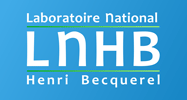Dosimetric references in external radiotherapy and brachytherapy

Small fields, very high rate beams, low energy beams used for contact radiotherapy
Radiation therapy techniques have undergone profound changes in recent years. Ongoing and future innovations will bring about further changes in this area in the near future. Metrology supports these evolutions and proposes solutions to ensure metrological traceability of new practices.
Dosimetric characterization of small fields
This study aims to meet the needs of dosimetric references adapted to very small radiotherapy fields (< 1 cm²), such as those used for Intensity Modulation Conformational Radiotherapy (IMCR) and stereotactic radiotherapy.
Dosimetric references, in terms of absorbed dose at the reference point, are usually established using dosimeters of smaller dimensions than those of the irradiation field. The decreasing signal output from primary detectors with their sizes does not currently allow the establishment of references in small fields.
The LNHB is exploring a new approach based on a non-point dosimetric quantity, the dose-area product, which characterizes, in a reference plane, the absorbed dose integrated on a given surface area larger than the size of the field. A specific graphite calorimeter is used to measure this quantity in a primary manner. The central element of this instrument, the core, has a cross-section of 7 cm² (⌀ = 3 cm), which is larger than the section of the measured radiation beams. Combined with a relative measurement of the 2D dose distribution, e.g. using a Gafchromic film, this measurement can provide access to the absorbed dose at the reference point used for commissioning medical LINACs.
The introduction of this quantity to users of radiotherapy services is currently being studied.
COLLABORATIVE PROJECT:
– European project: Metrology for radiotherapy using complex radiation fields, EMRP HLT09
https://www.euramet.org/Media/docs/EMRP/JRP/JRP_Summaries_2011/Health_JRPs/HLT09_Publishable_JRP_Summary.pdf
– Jean-Marc Bordy et al. Metrology for radiotherapy using complex radiation fields, HLT09 EMRP Project – (2015) 17th International Congress of Metrology,
DOI: 10.1051/metrology/201509003
Direct link: http://cfmetrologie.edpsciences.org/articles/metrology/pdf/2015/01/metrology_metr2015_09003.pdf
REFERENCES:
– S. Dufreneix, A. Ostrowsky, M. Le Roy, L. Sommier, J. Gouriou, F. Delaunay, B. Rapp, J. Daures, J-M. Bordy, Using a dose-area product for absolute measurements in small fields: a feasibility study, (2016), Phys. Med. Biol.
DOI:10.1088/0031-9155/61/2/650
– S. Dufreneix, A. Ostrowsky, B. Rapp, J. Daures and J-M. Bordy, Accuracy of a dose-area product compared to an absorbed dose to water at a point in a 2 cm diameter field (2016), Medical Physics, 43, 4085-4092
DOI: 10.1118/1.4953207
– A. Ostrowsky, J.M. Bordy, J. Daures, L. De Carlan, F. Delaunay, Dosimetry for small size beams such as IMRT and stereotactic radiotherapy, is the concept of dose at a point still relevant? Proposal for a new methodology, CEA-R-6243. CEA – LNHB F-91191 Gif-sur-Yvette Cedex
Low-energy radiotherapy
Low-energy X-photons (< 50 keV) are used in intraoperative and contact radiotherapy to deliver a dose at a short distance from the emission source of radiation. Today, in order to deliver the prescribed dose, medical physicists can only use the abacus of absorbed dose distribution in water supplied by the manufacturer with the contact radiotherapy device. It is necessary to be able to establish a dosimetric reference independent of the manufacturer, to confirm the validity of the charts provided for each device and to make their metrological follow-up.
The LNHB studies the realization of references in kerma in air and absorbed dose in water adapted to each type of apparatus. For this purpose, laboratory reference X-ray beams are modified to produce the same energy spectrum as user devices. These beams are characterized in dosimetric terms using primary standards, such as ionization chambers with air walls. They can then be used to calibrate transfer dosimeters, which in turn will be used to calibrate X-ray equipment in radiotherapy services. They will also make it possible, via quality control verification techniques, to verify the manufacturers’ charts.
REFERENCES:
– J.-P. Gérard, S. Marcie, O. Croce, S. Hachem, R. Trimaud, J.-M. Bordy, M. Denozière, A. Courdi, K. Benezery, J.-M. Hannoun Levi, N. Barbet, Développement de l’appareil Papillon 50TM et de ses applicateurs pour la radiothérapie 50 kV des cancers du rectum et de la peau, (2012), Ingénierie et Recherche Biomédicale IRBM, Vol. 33 issue 2 April 2012 page 109-116.
Doi : 10.1016/j.irbm.2012.01.003
– O. Croce. S. Hachem, E. Franchisseur, S. Marcié, J-P. Gérard, J.-M. Bordy, Contact radiotherapy using a 50 kV X-ray system: evaluation of relative dose distribution with the Monte-Carlo code PENELOPE and comparison with measurements, (2012), Radiation Physics and Chemistry.
Doi:10.1016/j.radphyschem.2012.01.033
Brachytherapy
As an alternative to external radiotherapy, brachytherapy consists of introducing a radioactive source within the patient, as close as possible to the cancerous tumour to be treated. This treatment method delivers a high dose to the target volume while at the same time saving the surrounding healthy tissue. One hundred thousand patients are treated per year in Europe, including eight thousand in France for gynaecological, prostate and ENT tumours.
In recent years, some medical services have equipped themselves with 60Co source projectors for treatments that were previously carried out with 192Ir sources. The LNHB had a reference air kerma reference for high flow brachytherapy with 192Ir. This was based on the measurement using a medical-type cavity ionization chamber with low-energy response, previously calibrated in the 60Co, 137Cs and 250 kV RX reference beams. In order to renew its source projector, the LNHB chose a multi source projector, 192Ir and 60Co. The aim of the study is to make a new reference for 192Ir and to establish a new one for 60Co using the same method.
LNHB has also developed a primary reference for LDR brachytherapy using 125I sources. Implantation of radioactive sources such as iodine 125 closer to the tumour is one of the most widely used techniques currently employed to treat ophthalmic and prostate cancer. The dedicated instrument consists of an innovative ionization chamber with toroidal shaped air walls and gives access to the two reference quantities, the kerma in air and the absorbed dose in water. Its specific shape surrounding the source makes it possible to avoid possible emission anisotropy.
